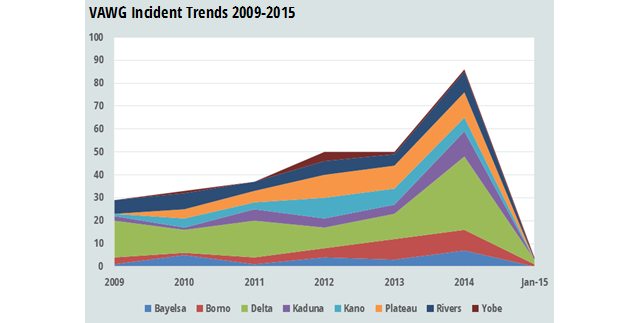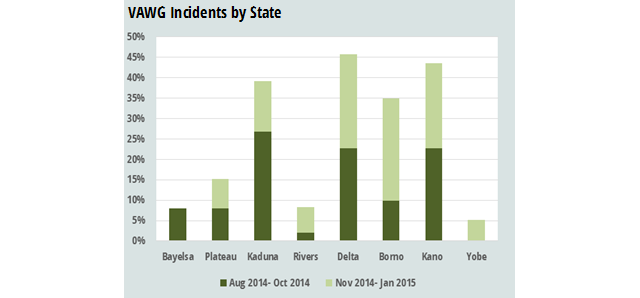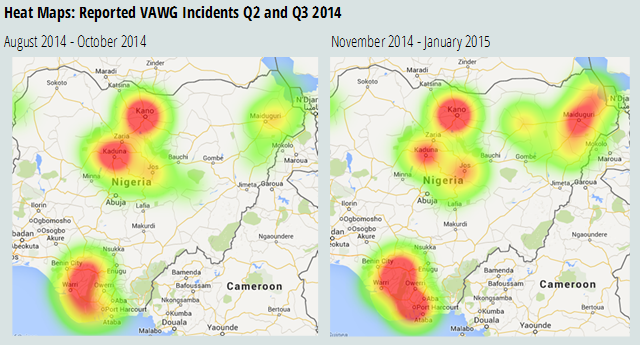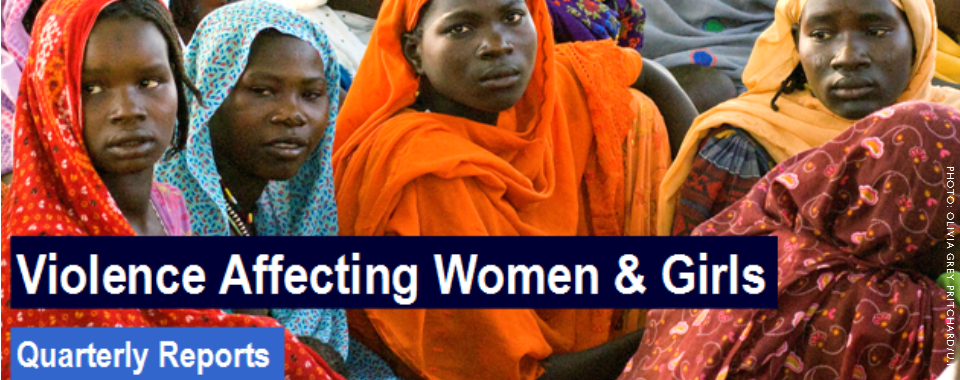BY PATRICIA TAFT*
The following report summarizes the main findings from data collection and analysis for the November 2014 to January 2015 period.
The number of overall incidents and fatalities reported in 2014 across the eight target states shows the highest levels of violence since 2009. While types of violence vary across states and time periods, the North East remains the most violent region, led by Borno State.
VAWG has followed this national trend, with the overall situation deteriorating during 2014 and into January 2015. With steadily increasing VAWG incident reports year on year, reported incidents rose by over 30% in 2014 from 2013 based on Nigeria Watch data.
Of the eight target states, Borno, Kano, and Plateau have shown the sharpest increases in violence longitudinally. The root causes of violence tend to differ by region. In the South-South states of Delta and Rivers, VAWG incidents often occur within the context of domestic, criminal and cult violence; with women being both targets as well as innocent bystanders swept up in the general insecurity. Particularly in Delta State, incidents of domestic abuse dominate, although there have also been several instances of kidnapping and abductions perpetrated against female family members of high ranking political or community leaders. In the North East and increasingly North West, VAWG tends to occur in the context of the insurgency and counter-insurgency. This has become particularly salient in the past quarter in Borno state where JAS, more commonly known as Boko Haram, continues to be active and the kidnapping of girls is rampant. In the North Central and North West regions, VAWG issues have related to forced marriages and domestic violence, with rape targeting young girls prevalent. In Kano, Kaduna and Plateau, incidents of VAWG have also frequently related to communal violence, with women and girls caught up in various conflicts between groups which included the destruction of homes and businesses. Women have also been the target reprisal attacks over perceived injustices related to land and livestock.
Trends in Violence
Insurgency and Suicide Bombing
The insurgency campaign being staged by Boko Haram in northern states is having a direct impact on women and girls. The two key trends which have emerged in reports during this quarter relate to the specific targeting of women and girls to further the goals of the insurgency.
The first trend is an upsurge in mass abductions and killings of women and girls in Borno and Yobe states. Though abductions of women and girls has emerged as a key tactic of Boko Haram militants over the past year, Borno has seen a steady increase in reported abductions in the last three months. From the 13 reported abductions in November, this increased to 187 reported in December and a further 300 women and children abducted in January 2015. Neighboring Yobe experienced an upsurge in abductions of women and children in January. In addition to abductions, the systematic targeted killing of vulnerable groups during insurgency attacks, has resulted in significant death tolls of women. In one particular attack on Baga in Borno state in January, reports suggest that of the estimated 1600 to 2000 casualties the majority were elderly women and children.
The second trend is the use of young girls as suicide bombers to carry out Boko Haram attacks. Borno state has seen the most reports of female suicide bombers, with nine girls detonating devices in crowded civilian areas since November 2014. The reported ages of the girls ranged from 9 to 17 years of age. Most alarming are the reports that emerged in December which suggested 52 girls were trained as suicide bombers and currently at large. This use of young women to carry out such terrorist attacks is spreading beyond Borno, with reports emerging in Yobe and Kano. In January two girls exploded themselves in Yobe, while two attacks were carried out in December in Kano, with a third attempt foiled by police.

Heat map: Female Suicide Bombings in November 2014-January 2015. Observatory Screenshot (All sources) – http://www.nsrp-nigeria.org/
Localized Sexual Violence and Brutality
Another trend which continues to emerge in the South South state of Delta and North West states of Kano and Kaduna is rape and gratuitous violence on a localized level against women and girls. Reports of at least 19 female fatalities in the November-January period emerged from Delta, and in excess of 11 reported incidents of sexual violence against women and girls. The patterns of degradation and brutality towards women is apparent in reports such as the murder of four pregnant women in Delta over the past quarter, illegal abortions performed by native doctors, as well as the abduction of women by Fulani herdsmen during intercommunal clashes. In Kano and Kaduna intracommunal violence remained prevalent in November and December, including ten reports of incidents relating to child sex abuse, murder, domestic violence and forced child marriages.
Pre-election violence
While data suggests that violence against women and girls has risen consistently over 2014, the link between this violence and growing pre-election tensions became more evident over the past quarter. In regions that have seen spikes in election-related clashes such as the South South, reports emerged of female victims. For example, in January a party chairman’s wife was attacked during political unrest in Rivers. It is anticipated that this trend is likely to continue as general violence levels grow in the lead up to 2015 elections.
Reporting trends across states and LGAs

Trend in VAWG Incidents Reported in NRSP States. Data source: Nigeria Watch
Data compiled on the Observatory Platform suggests that both VAWG as well as overall violence and conflict risk continues to worsen in the eight NSRP states, with the month of July 2014 being the worst since January 2009. With regards specifically to VAWG, reported incidents have increased consistently year on year since 2009. With 85 incidents reported by Nigeria Watch in 2014, this is a significant upward trend from previous years with 2013 reporting 65 incidents and 2012 reporting 56 incidents.
An automated word search of Nigeria Watch and ACLED data (two sources with methodologies that quantify trends in violence and insecurity) indicates that the state with the highest number of reported VAWG incidents during the period of November 2014-January 2015 was Borno. The lowest number of reports related to Yobe. At the LGA Level, Maiduguri, Borno state had the highest percentage of VAWG related incidents, followed by Oshimili South in Delta, Kukawa in Borno, and Nasarawa in Kano.
Findings in the Eight Target States
(November 2014 – January 2015)

VAWG Incidents in Q2 and Q3 by State. Incidents by state as a percentage of the total number of VAWG incidents in the respective period from all sources. Graph shows that the predominance of reports in the second period were in Borno, Delta and Kano, which was a change from the first period when Kaduna and Kano were the epicenters of reported VAWG incidents (all sources).
This summary report focuses on the NSRP’s eight target states during the time period November 2014 through January 2015. During this time period, reported violence affecting women and girls has continued to rise, making 2014 to the most violent year since we began tracking in 2009.
North East: Borno and Yobe States
Between November 2014 and January 2015, a reported 500 women and girls were abducted in Borno state. Borno has consistently displayed the highest levels of gender-related violence across all states in the program over the past three months. The catalyst for these incidents is the insurgency staged by Boko Haram. The asymmetrical warfare tactics used by Boko Haram have evolved over the course of its campaign to target women and girls.
One troublesome trend is the use of young female suicide bombers to carry out terrorist attacks in crowded civilian areas. A reported 9 female suicide bombers as young as 10 years old have carried out suicide attacks in Borno since November 2014. This trend is likely to continue into 2015, with reports in December that 52 trained female bombers remained at large.
Numbers of abductions worsened in January, when 300 women and girls were taken in Baga by Boko Haram. This was an increase from December when 187 abductions were reported, including 185 victims kidnapped in a Boko Haram raid of Damboa.
Targeting vulnerable groups including women unable to flee insurgency attacks resulted in 63 reported deaths for December. This worsened significantly in January, when Boko Haram staged an attack on Baga over a four day period. Reports suggest between 1600 and 2000 people died, of which the majority were elderly women and children. It was during this same attack, that the 300 women and children were abducted.
General insurgency-related violence has remained prevalent in Yobe over the past few months, however a new trend in specifically targeted violence against women and girls emerged in January 2015. While a number of suicide bombing attacks and attempted attacks were reported throughout 2014, January 2015 marks a shift to the use of young females to carry out the attacks in Yobe. Two women aged between 15 and 17 years old carried out a suicide bombing attack in a crowded market, reportedly killing 39 people. This suggests an expansion of the female suicide bombing tactic already prevalent in neighboring Borno state. A spike in the abduction of women and girls occurred in January 2015 in Yobe, compared with November and December 2014 which had no reports. An unknown number of women and children were reported to have been kidnapped during a Boko Haram attack in Katarko village.

VAWG Incidents in Q2 and Q3 by LGA. VAWG Incidents by top 13 LGAs as a percentage of the total number of VAWG incidents in the respective period. Graph shows that while at the state level the preponderance of reports were in Delta, at the LGA level, most reports were reported in Maiduguri, Borno State (all sources).
North West: Kano and Kaduna States
Kano has seen a consistently high levels of gender-based violence this quarter with 20 incidents reported, compared with the 23 incidents last quarter. The exploitation of gender for the insurgency campaign waged by Boko Haram remains a significant issue in the state, along with localized sexual violence.
A worrying trend shared by the North East states of Borno and Yobe, is the use of young female suicide bombers. In December 2014 in Kano, a 13 year old girl was arrested by police carrying a suicide vest. Another two females carried out a suicide attack in a Kano textile market in the same month.
Rape of women and young girls was particularly prevalent in November, with four cases reported including a girl as young as 7 years old. In December, a 15 year old girl was abducted and sexually abused, and a woman’s 10 year old son was murdered by her jilted 14 year old daughter-in-law.
Kaduna had an overall decrease in reported incidents for this quarter with 12 reports, compared with the 27 reported incidents from last quarter. The higher numbers for the previous August-November 2014 period are partly due to the retrospective data provided by a partner organization, which highlighted important trends in domestic and sexual violence within Kaduna. General trends surrounding violence perpetrated against girls and women remained prevalent in the November 2014-January 2015 period. This was evident in the reports of an attempted rape of a small girl in November, and attempted marriage of a young girl to an elderly ill man. In December a woman was also cut with a machete by her husband, consistent with the types of domestic gender-violence reported in earlier months of 2014 in Kaduna.
An upsurge in targeted insurgency violence towards vulnerable groups also occurred in December in Kano, with 17 aged women and children killed in one village attack.
South South: Delta, Rivers and Bayelsa States
Delta remains one of the most troubling states for casualties, abductions and sexual violence against women and girls over the past three months. Sexual assault of girls as young as 10 years old were reported in Delta, with one disturbing incident of a rape of 9 and 10 year old sisters by their mother’s an HIV-positive boyfriend. Total reports of rape in the November 2014 to January 2015 period totaled 6 incidents.
Gratuitous violence targeting women and girls in Delta remained higher than any other state in the November to January period. This was evident in reports of abductions of women by Fulani herdsmen and ritualists, illegal abortions performed by native doctors, and one incident of a girl 10 year old girl being murdered by armed robbers. Four pregnant women were also killed in the same period. Three were murdered in cult clashes, while one women’s mutilated body was found along with other corpses in farmland.
With general incidents of violence in Rivers widespread over the past three months, there have been incidents of women becoming casualties to intercommunal and pre-election clashes.
During December, a mother and child were killed in the crossfire between rival cult groups in Rivers. In January, a woman along with a man were attacked and robbed by cultists. In the same month, a party chairman’s wife was attacked along with her husband during political unrest.
Despite high levels of election-related incidents, intercommunal tensions and crime fatalities in Bayesla state, no reports have emerged in the November 2014 to January 2015 period of gender-based violence.
North Central: Plateau State
Compared with the other states in the program, Plateau in the Middle Belt Region had lower instances of reported violence in the November 2014 to January 2015 period with seven incidents. These incidents related predominately to sexual and domestic violence, with five girls reported to have been raped. Three abductions of women were attempted in November, and two instances of men assaulting their wives also emerged in January. In one of these instances, the woman’s husband left her with significant machete wounds and a damaged eye socket inflicted by a bottle.

Heat maps: Reported VAWG Incidents Q2 and Q3. Observatory Screenshot (All sources) – http://www.nsrp-nigeria.org/
*Kendall Lawrence and Hannah Blyth also contributed to this report.
